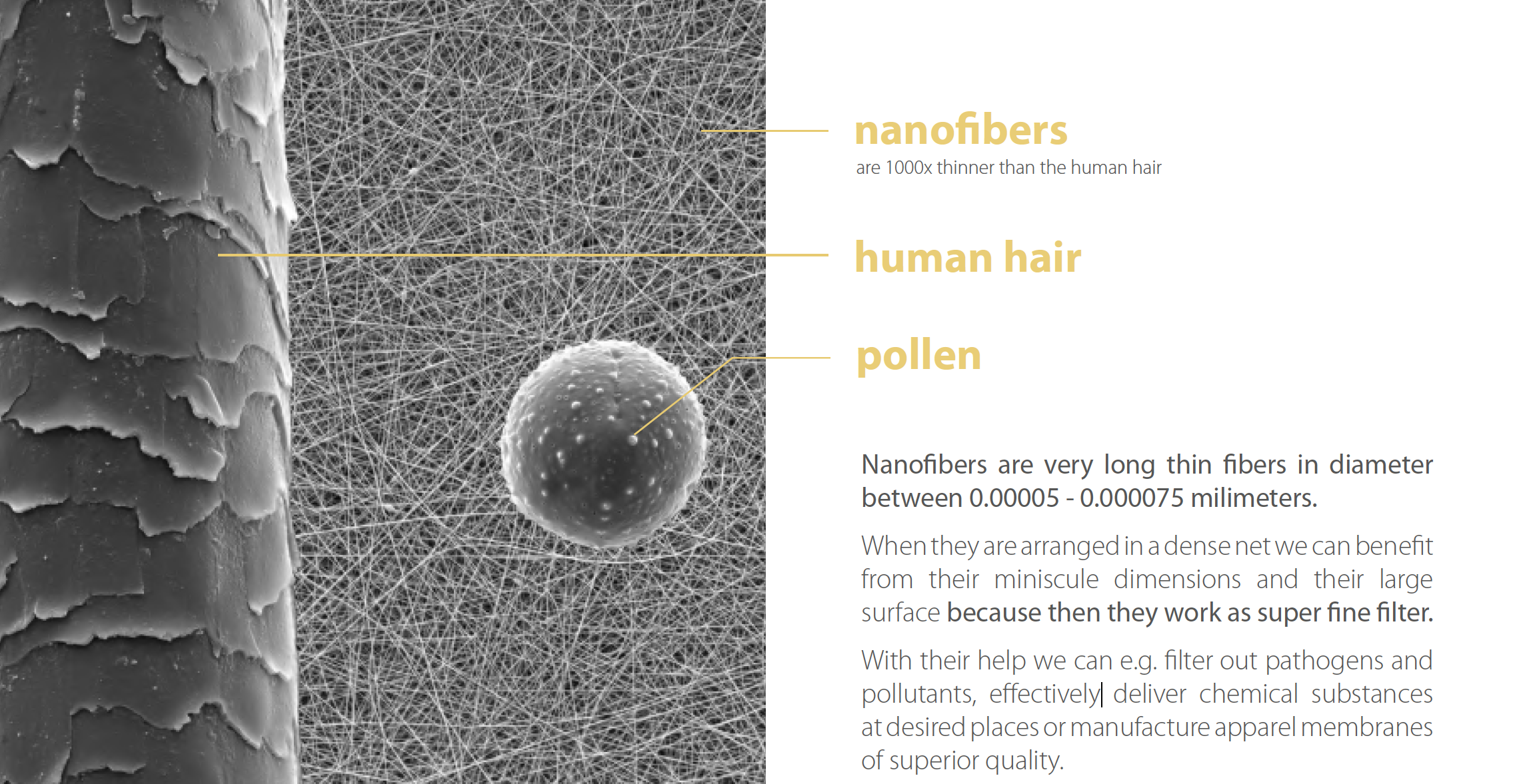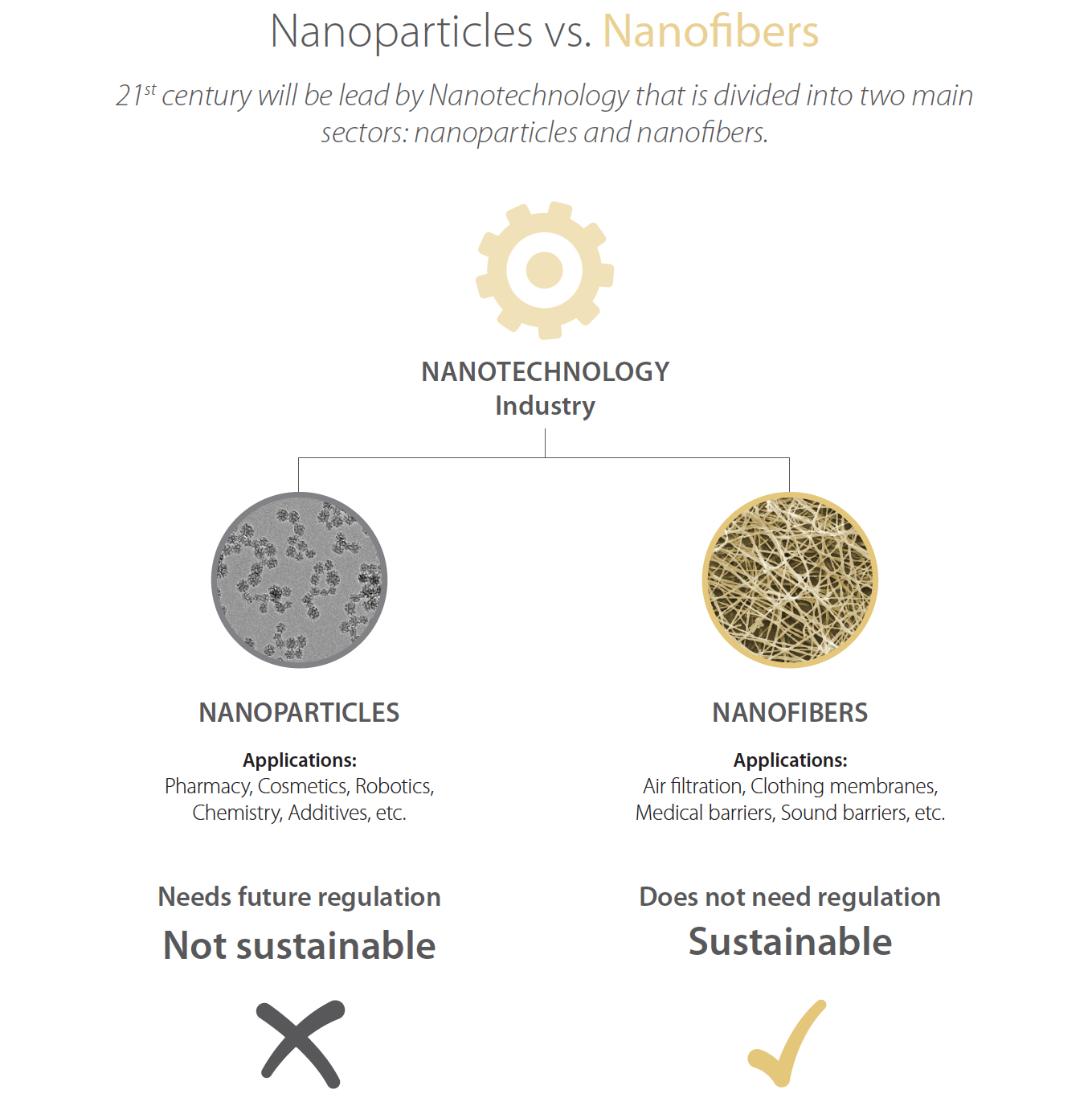Nanofibers
Nanofibers
Nanofibers

Nanofibers are very long thin fibers in diameter between 0.00005 - 0.000075 milimeters.
When they are arranged in a dense net we can benefit from their miniscule dimensions and their large surface because then they work as a super fine filter.
With their help we can e.g. filter out pathogens and pollutants, effectively deliver chemical substances at desired places or manufacture apparel membranes of superior quality.

Background
Nanoparticles are used since the seventies and now they represent an ordinary branch with thousands of dealing companies. There is only low opportunity for growth while main players are determined already.
Nanofibers represent a new technology of the 21st century with only dozens of dealing companies. They bring a huge and current opportunity for growth. “The nanofiber technology market has been forecast to increase by 30.3 % p. a.”
Source: BCC Research, 2013
Chemical health effect
Typical example of nanoparticles is represented by silver nanoparticles. Although several studies described the toxicity of silver nanoparticles to lungs, liver, skin, brain and reproductive organs, these particles are widely used in a variety of commercial products.
Nanofibers are made from ordinary polymers such as Polyvinylidene fluoride (PVDF), Polypropylene or Polyamide. These materials are highly non-reactive, inert, common in everyday use and often approved for example for contact with foodstuffs. You can find them in automotive industry, packaging industry or pharmaceutical and food industry.
Physical health effect
The smaller the particles, the bigger the problem. For example, dental composites contain high amounts of nanosized filler particles. Dental personnel (and patients) inhale nanosized dust particles (<100 nm) during abrasive procedures to shape, finish or remove restorations. These particles penetrate the alveoli and may cause serious respiratory problems. Some studies found an association between high nanoparticles concentration and pulmonary inflammation or cytotoxicity.
Source: Van Landuyt, K. L., Hellack, B., Van Meerbeek, B., Peumans, M., Hoet, P., Wiemann, M., ... & Asbach, C. (2014). Nanoparticle release from dental composites. Acta biomaterialia, 10(1), 365-374. Akhtar, M. J., Ahamed, M., Kumar, S., Siddiqui, H., Patil, G., Ashquin, M., & Ahmad, I. (2010). Nanotoxicity of pure silica mediated through oxidant generation rather than glutathione depletion in human lung epithelial cells. Toxicology, 276(2), 95-102.
Because of the manufacturing technology, nanofiber filter is produced in the form of the infinite fiber with no releasing nanoparticles. The fiber creates an extremely strong structure with no danger of skin or mucous membrane irritation. Conversely, the nanofiber filter is the only effective tool able to capture dangerous nanoparticles.
Breathing
Nanoparticles may cross the mucous membrane inside the nose and then reach the brain through the olfactory nerve. Materials which by themselves are not very harmful could be toxic if they are inhaled in the form of nanoparticles. The effects of inhaled nanoparticles in the body may include lung inflammation and heart problems. Studies in humans show that breathing in diesel soot causes a general inflammatory response and alters the system that regulates the involuntary functions in the cardiovascular system, such as control of heart rate.
Source: Hoet, P., Brüske-Hohlfeld, I., Salata, O. (2004). Nanoparticles – known and unknown health risks. Journal of Nanobiotechnology, 10.1186/1477-3155-2-12.
Nanofiber membrane filter forms a mechanical barrier against air pollution, pollen, dust and microorganisms. It prevents human body from inhaling these nanoparticles and protects human health from infections and allergies.
Potential regulation
Because of described health risks, we can see some discussions related to potential regulation of production and using of nanoparticles. These initiatives appear for example in World Health Organisation and European Commission. One of the most dangerous substances which could be soon restricted is fluorocarbon. This material is in the nanoparticle form used for car body coating.
Nanofibers are inert and show stable characteristics during many years. They don’t react with air or chemicals and don’t release dangerous particles. That is the reason why no regulation of nanofibers use is appearing.

